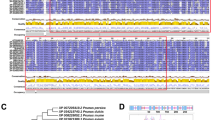Abstract
We have shown previously that transcripts corresponding to the cDNA clone pBH72-F1, with similarities to O-methyltransferases (OMT), accumulated in barley leaves in response to attack by the pathogenic fungus Blumeria graminis (Plant Mol Biol 26 (1994) 1797). To investigate the accumulation pattern in the defence response and the organ localization of the pBH72-F1-encoded polypeptide (F1-OMT), an antiserum was raised against Escherichia coli expressed F1-OMT. The 43 kDa protein was absent in normal leaves but accumulated strongly in response to pathogen attack. The F1-OMT protein accumulated faster in barley lines inoculated with an avirulent B. graminis isolates compared to a virulent isolate. Additionally, F1-OMT related proteins were detected in developing kernels. F1-OMT was expressed as a functional enzyme in E. coli and the substrate specificity was investigated. The enzyme exhibited OMT activity towards flavonoid aglycones with the highest activity against apigenin (4′,5,7-trihydroxyflavone). In contrast, caffeic acid did not serve as substrate for F1-OMT. The product of F1-OMT was analyzed by HPLC and GC-MS and found to be genkwanin (4′,5-dihydroxy-7-methoxyflavone). Initial velocity data were best represented by a sequential bi-bi mechanism, and kinetic parameters of KSAM=10.9µM,Kapigenin=4.6µM and a specific activity of 0.45 µkat/g were obtained. Barley F1-OMT, apigenin 7-O-methyltransferase, is suggested to be involved in the production of a methylated flavonoid phytoalexin.
Similar content being viewed by others
References
Boudet AM, Lapierre C, Grima-Pettenati J: Tansley review no. 80: biochemistry and molecular biology of lignification. New Phytol 129: 203–236 (1995).
Boyd LA, Smith PH, Foster EM, Brown JKM: The effects of allelic variation at the Mla resistance locus in barley on the early development of Erysiphe graminis f.sp. hordei and host responses. Plant J 7: 959–968 (1995).
Christensen AB: Phenylpropanoids in the defence response of barley. Ph.D thesis, Royal Veterinary and Agricultural University, Frederiksberg, Denmark (1997).
Clark TA, Zeyen RJ, Smith AG, Carver TLW, Vance CP: Phenylalanine ammonia lyase mRNA accumulation, enzyme activity and cytoplasmic response in barley isolines, differing at Ml-a and Ml-o loci, attacked by Erysiphe graminis f.sp. hordei. Physiol Mol Plant Path 44: 171–185 (1994).
Collinge DB, Bryngelsson T, Gregersen PL, Smedegaard-Petersen V, Thordal-Christensen H: Resistance against fungal pathogens: its nature and regulation. In: Basra AS, Basra RK (eds) Mechanisms of Environmental Stress Resistance in Plants, pp. 335–372. Harwood Academic Publishers, London (1997).
De Luca V, Ibrahim RK: Characterization of three distinct flavonol O-methyltransferases from Chrysosplenium americanum. Phytochemistry 21: 1537–1540 (1982).
Edwards R, Dixon RA: Isoflavone O-methyltransferase activities in elicitor-treated cell suspension cultures of Medicago sativa. Phytochemistry 30: 2597–2606 (1991).
Edwards R and Dixon RA: Purification and characterization of S-adenosyl-L-methionine: caffeic acid 3-O-methyltransferase from suspension cultures of alfalfa (Medicago sativa L.). Arch Biochem Biophys 287: 372–379 (1991).
Gregersen PL, Christensen AB, Sommer-Knudsen J, Collinge DB: A putative O-methyltransferase from barley is induced by fungal pathogens and UV light. Plant Mol Biol 26: 1797–1806 (1994).
Gregersen PL, Thordal-Christensen H, Förster H, Collinge D: Differential gene transcript accumulation in barley leaf epidermis and mesophyll in response to attack by Blumeria graminis f.sp hordei. Physiol Mol Plant Path, In press.
Harlow E, Lane D: Antibodies, a laboratory manual. Cold Spring Harbor Laboratory, Cold Spring Harbor, NY (1988).
He X, Dixon R: Affinity chromatography, substrate/product specificity, andamino acid sequence analysis of an isoflavonoid O-methyltransferase from alfalfa (Medicago sativa L.). Arch Biochem Biophys 336: 121–129 (1996).
Ibrahim RK, De Luca V, Khouri H, Latchinian L, Brisson L, Charest PM: Enzymology and compartmentation of polymethylated flavonol glucosides in Chrysosplenium americanum. Phytochemistry 26: 1237–1245 (1987).
Khouri HE, Tahara S, Ibrahim RK: Partial purification characterization and kinetic analysis of isoflavone 5-O-methyltransferase from yellow lupin roots. Arch Biochem Biophys 262: 1537–1540 (1988).
Knogge W, Weissenböck G: Purification, characterization, and kinetic mechanism of S-adenosyl-L-methionine: vitexin 2″-O-rhamnoside 7-O-methyltransferase of Avena sativa L. Eur J Biochem 140: 113–118 (1984).
Kodama O, Miyakawa J, Akatsuka T, Kiyosawa S: Sakuranetin, a flavanone phytoalexin from ultraviolet-irradiated rice leaves. Phytochemistry 11: 3807–3809 (1992).
Kuroki G, Poulton JE: The para-it O-methylation of apigenin to acacetin by cell-free extracts of Robinia Pseudoacacia L. Z Naturforsch C 36: 916–920 (1981).
Laks PE, Pruner MS: Flavonoid biocides: structure/activity relations of flavonoid phytoalexin analogues. Phytochemistry 28: 87–91 (1989).
Poulton JE: Transmethylation and demethylation reactions in the metabolism of secondary plant products. In: Strump PK, Conn EE (eds) The Biochemistry of Plants: A Comprehensive Treatise, vol 7, pp. 667–723. Academic Press, London (1981).
Preisig CL, Matthews DE, VanEtten HD: Purification and characterization of S-adenosyl-L-methionine:6ahydroxymaackiain 3-O-methyltransferase from Pisum sativum. Plant Physiol 91: 559–566 (1989).
Rakwal R, Hasegawa M, Kodama O: A methyltransferase for synthesis of the flavanone phytoalexin sakuranetin in rice leaves. Biochem Biophys Res Comm 222: 732–735 (1996).
Shiraishi T, Yamada T, Nicholson RL, Kunoh H: Phenylalanine ammonia-lyase in barley: activity enhancement in response to Erysiphe graminis f.sp. hordei (Race 1) a pathogen, and Erysiphe pisi, a nonpathogen. PhysiolMol Plant Path 46: 153–162 (1995).
Thordal-Chrisensen H, Brandt J, Cho BH, Rasmussen SK, Gregersen PL, Smedegaard-Petersen V, Collinge DB: cDNA cloning and characterization of two barley peroxidase transcripts induced differentially by the powdery mildew fungus Erysiphe graminis. Physiol Mol Plant Path 40: 395–409 (1992).
Tobias RB, Larson RL: Characterization of maize pollen flavonoid 3′-O-methyltransferase activity and its in vivo products. Biochem Physiol Pfl 187: 243–250 (1991).
VanEtten HD, Matthews DE, Matthews PS: Phytoalexin detoxification: Importance for pathogenicity and practical implications. Annu Rev Phytopath 27: 143–164 (1989).
Author information
Authors and Affiliations
Rights and permissions
About this article
Cite this article
Christensen, A.B., Gregersen, P.L., Olsen, C.E. et al. A flavonoid 7-O-methyltransferase is expressed in barley leaves in response to pathogen attack. Plant Mol Biol 36, 219–227 (1998). https://doi.org/10.1023/A:1005985609313
Issue Date:
DOI: https://doi.org/10.1023/A:1005985609313




